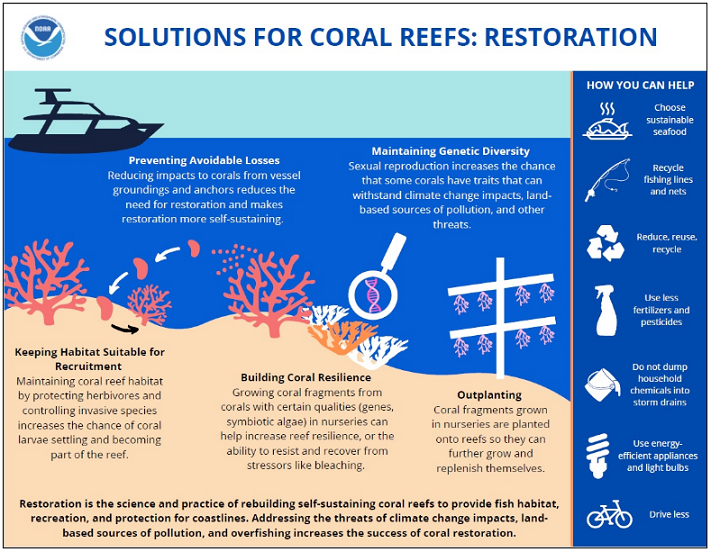- ABOUT US
- PROGRAM AREAS
- CONSERVATION APPROACH
- EDUCATION
- MULTIMEDIA
- Choose sustainable seafood
- Recycle fishing lines and nets
- Reduce, reuse, recycle
- Use less fertilizers and pesticides
- Do not dump household chemicals into storm drains
- Use energy efficient appliances and light bulbs
- Drive less
Solutions for Coral Reefs: Restoration
This infographic describes what coral restoration is, different aspects of restorations, and steps that individuals can take to support successful restoration.

Infographic Transcript: Solutions for Coral Reefs: Restoration
Restoration is the science and practice of rebuilding self-sustaining coral reefs to provide fish habitat, recreation, and protection for coastlines. Addressing the threats of climate change impacts, land-based sources of pollution, and overfishing increases the success of coral restoration.
Preventing Avoidable Losses
Reducing impacts to corals from vessel groundings and anchors reduces the need for restoration and makes restoration more self-sustaining.
Maintaining Genetic Diversity
Sexual reproduction increases the chance that some corals have traits that can withstand climate change impacts, land-based sources of pollution, and other threats.
Keeping Habitat Suitable for Recruitment
Maintaining coral reef habitat by protecting herbivores and controlling invasive species increases the chance of coral larvae settling and becoming part of the reef.
Building Coral Resilience
Growing coral fragments from corals with certain qualities (genes, symbiotic algae) in nurseries can help increase reef resilience, or the ability to resist and recover from stressors like bleaching.
Outplanting
Coral fragments grown in nurseries are planted onto reefs so they can further grow and replenish themselves.
How Can You Help?
About Us

The NOAA Coral Reef Conservation Program was established in 2000 by the Coral Reef Conservation Act. Headquartered in Silver Spring, Maryland, the program is part of NOAA's Office for Coastal Management.

The Coral Reef Information System (CoRIS) is the program's information portal that provides access to NOAA coral reef data and products.
Work With US
U.S. Coral Reef Task Force
Funding Opportunities
Employment
Fellowship Program
Contracting Assistance
Graphic Identifier
Featured Stories Archive

Access the archive of featured stories here...
Feedback
Thank you for visiting NOAA’s Coral Reef Conservation Program online. Please take our website satisfaction survey. We welcome your ideas, comments, and feedback. Questions? Email coralreef@noaa.gov.
Stay Connected
Contact Us
NOAA’s Coral Reef Conservation Program
SSMC4, 10th Floor
1305 East West Highway
Silver Spring, MD 20910
coralreef@noaa.gov
